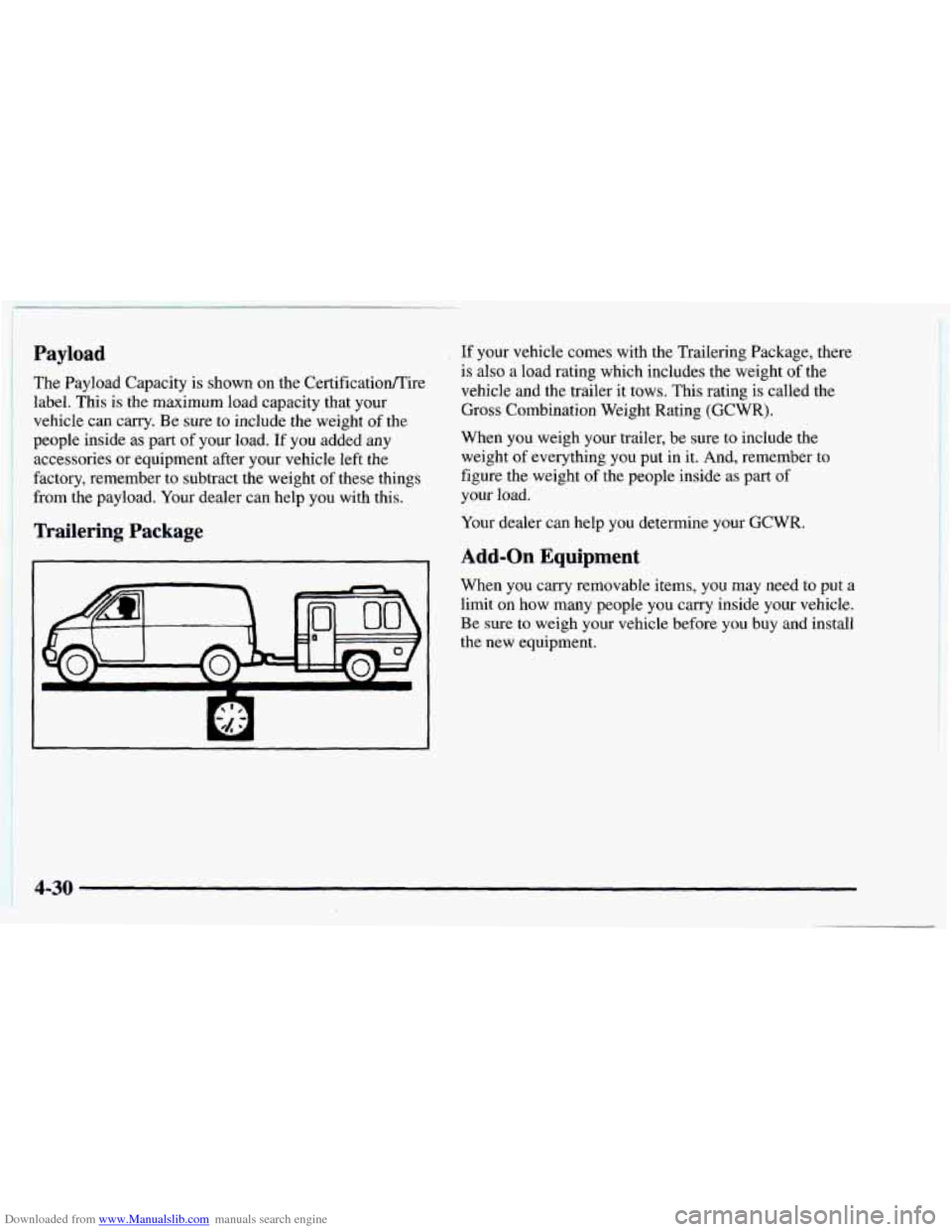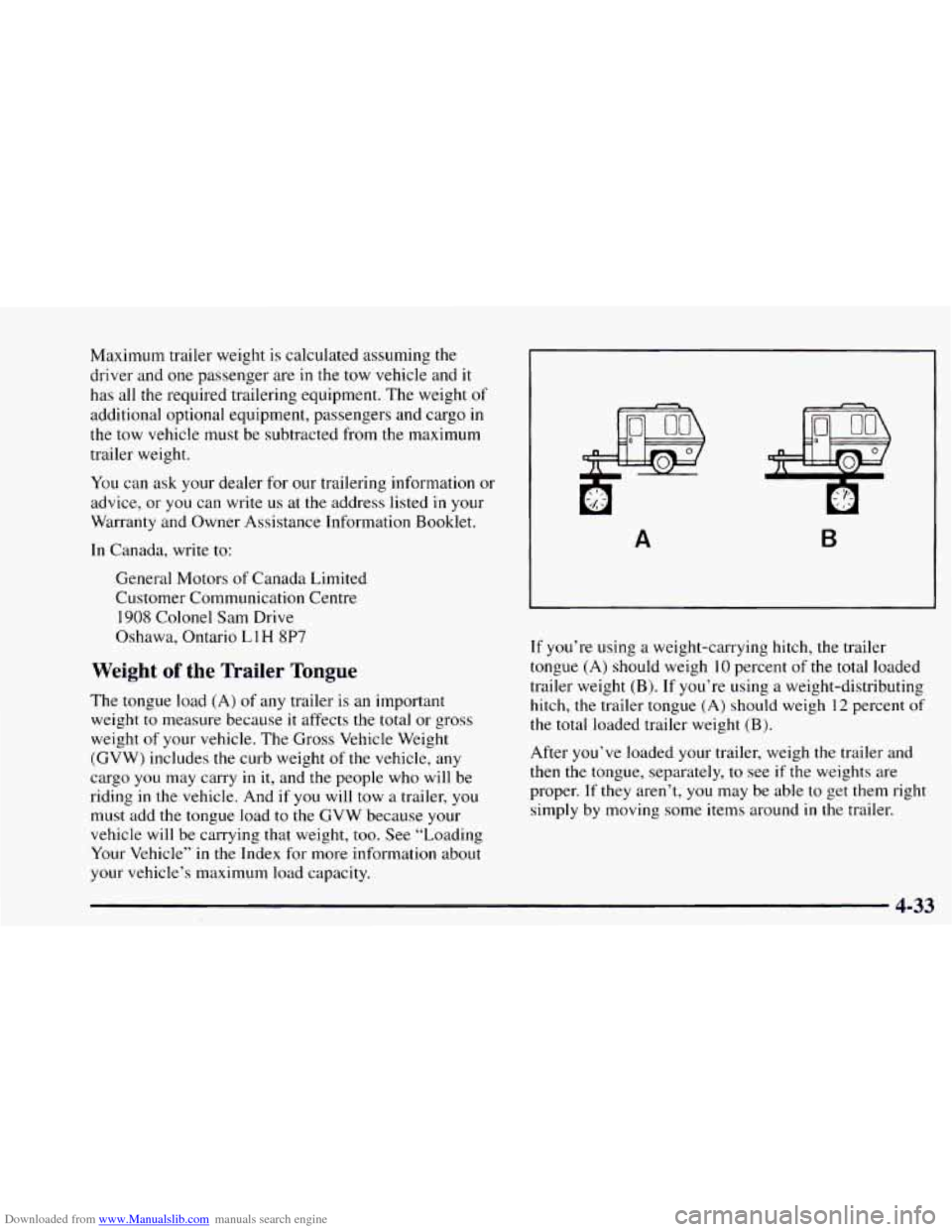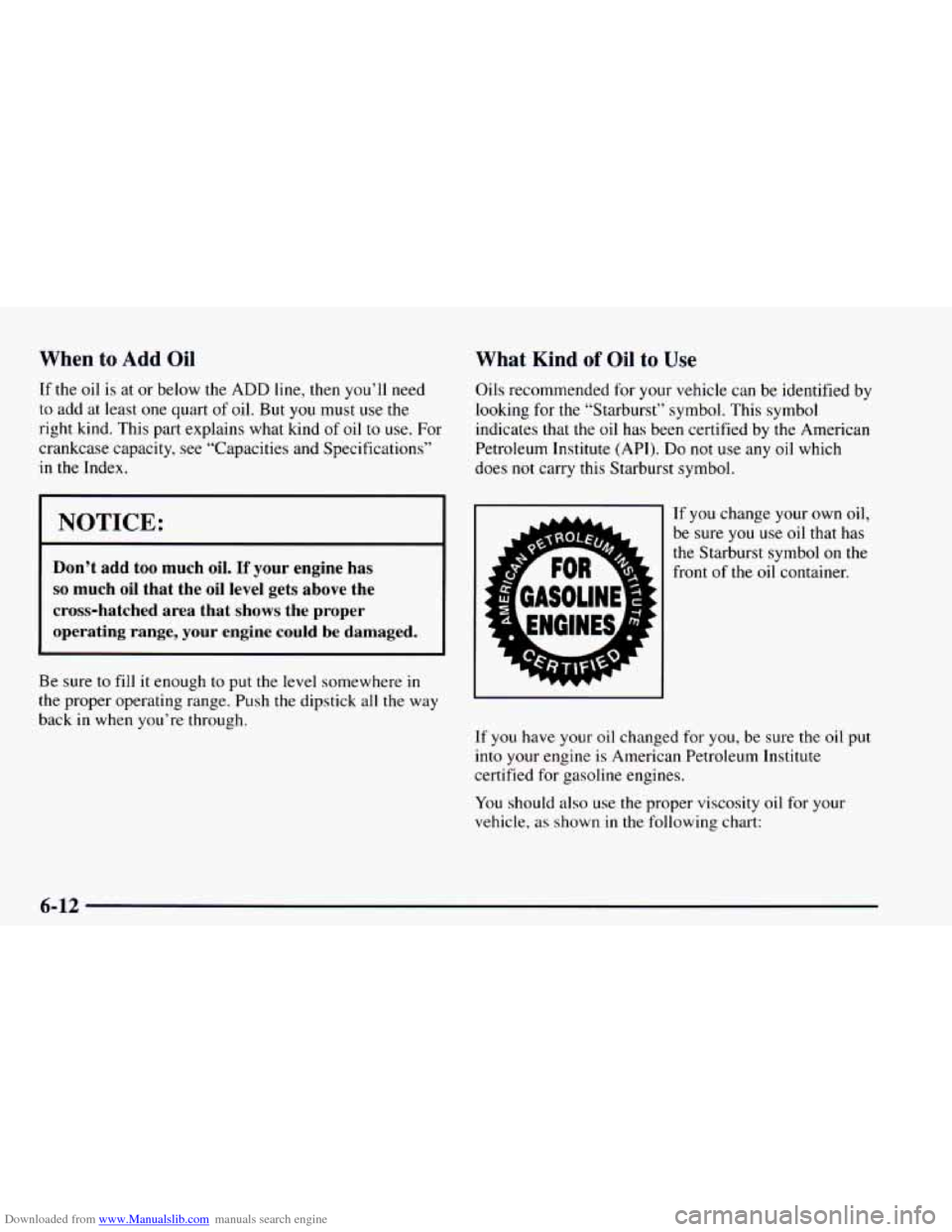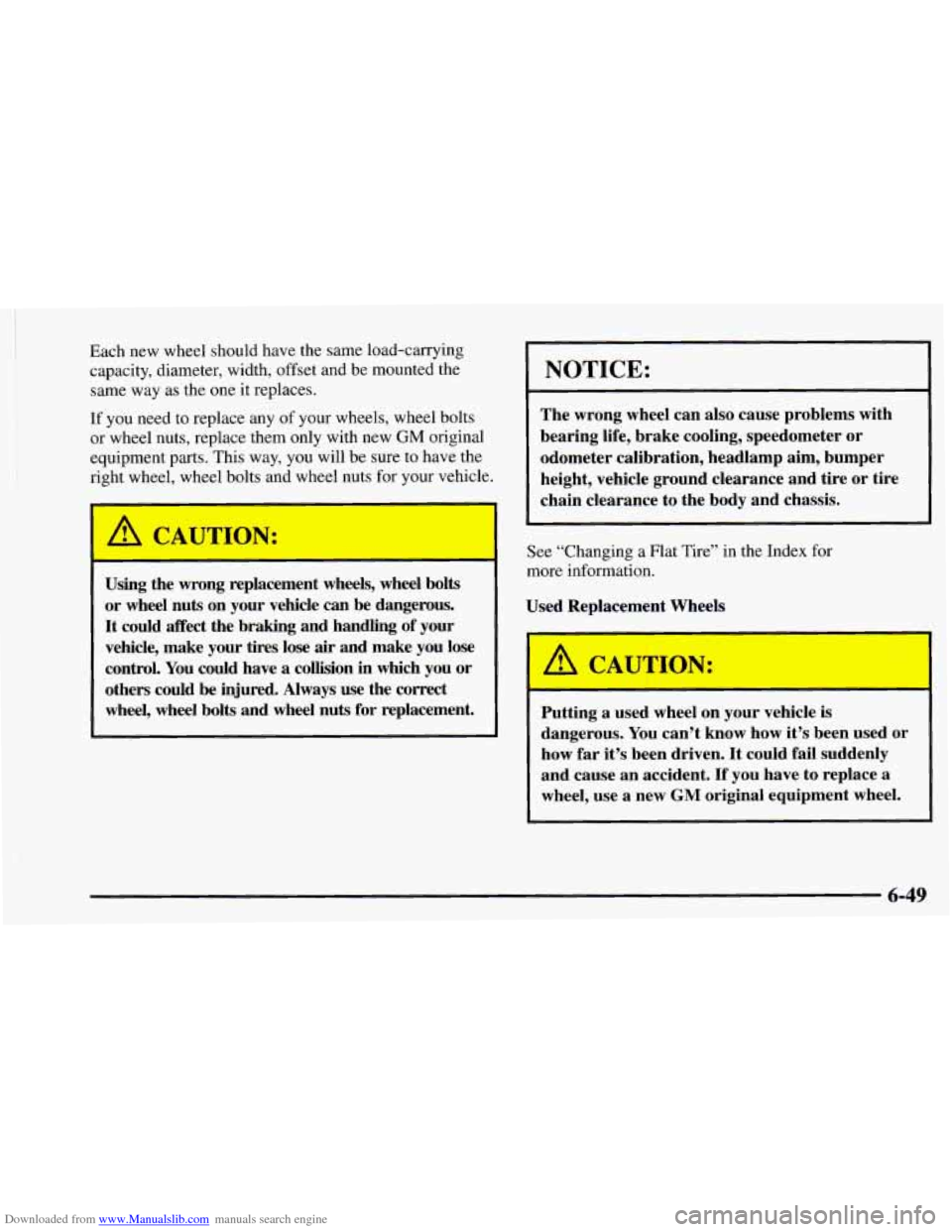1997 CHEVROLET ASTRO load capacity
[x] Cancel search: load capacityPage 124 of 404

Downloaded from www.Manualslib.com manuals search engine ~~ NOTICE:
Loading cargo that
weighs more than 200 lbs.
(91 kg) on the luggage carrier may damage your
vehicle. When you carry large things, never let
them hang over the rear or the sides of your
vehicle. Load your cargo
so that it rests on the
slats and does not scratch or damage the vehicle.
Put the cargo against the side rails and fasten it
securely to the luggage carrier. Put the main
weight as far forward
as you can.
Don’t exceed
the maximum vehicle capacity when
loading your vehicle. For more information on vehicle
capacity and loading, see “Loading Your Vehicle”
in
the Index.
To prevent damage or loss of cargo as you’re driving,
check now and
then to make sure the luggage carrier and
cargo are still securely fastened.
Ashtrays and Cigarette Lighter
The cigarette lighter is on the left of the engine
cover console.
To use the lighter, press it in all the way and let go.
When it’s done heating, it will pop back by itself.
NOTICE:
Don’t hold a cigarette lighter in with your hand
while it is heating.
If you do, it won’t be able to
back
away from the heating element when it’s
ready. That can make it overheat, damaging the
lighter and the heating element.
2-50
Page 204 of 404

Downloaded from www.Manualslib.com manuals search engine Loading Your Vehicle
The Certificationmire label in your vehicle will look
similar to this example. The
CertificatiodTire label is found on the rear edge of
the driver’s door. The label shows
the size of your
original tires and the inflation pressures needed to obtain
the gross weight capacity of your vehicle.
This is called the GVWR (Gross Vehicle Weight
Rating). The GVWR includes the weight of
the vehicle,
all occupants, fuel, cargo and tongue weight,
if pulling
a trailer.
The CertificationITire label also tells
you the maximum
weights for
the front and rear axles, called the Gross
Axle Weight Rating (GAWR). To find out the actual
loads on your front and rear axles,
you need to go to a
weigh station and weigh your vehicle. Your dealer can
help you with this. Be sure
to spread out your load
equally on both sides of the centerline.
Never exceed
the GVWR for your vehicle, or GAWR
for either the front or rear axle.
And,
if you do have a heavy load, you should spread it out.
4-28
Page 206 of 404

Downloaded from www.Manualslib.com manuals search engine Payload
The Payload Capacity is shown on the Certificationire
label. This is the maximum load capacity that your
vehicle can carry. Be sure to include the weight
of the
people inside as part of your load.
If you added any
accessories
or equipment after your vehicle left the
factory, remember to subtract the weight of these things
from the payload. Your dealer can help you with this.
Trailering Package
I I
I
DI
U -,A .-
If your vehicle comes with the Trailering Package, there
is also a load rating which includes the weight of the
vehicle and the trailer it tows. This rating is called the
Gross Combination Weight Rating
(GCWR).
When you weigh your trailer, be sure to include the
weight
of everything you put in it. And, remember to
figure the weight of the people inside as part of
your load.
Your dealer can help you determine your
GCWR.
Add-on Equipment
When you carry removable items, you may need to put a
limit on how many people you carry inside your vehicle.
Be sure to weigh
your vehicle before you buy and install
the new equipment.
4-30
Page 209 of 404

Downloaded from www.Manualslib.com manuals search engine Maximum trailer weight is calculated assuming the
driver and
one passenger are in the tow vehicle and it
has all the required trailering equipment. The weight of
additional optional equipment, passengers and cargo in
the tow vehicle must be subtracted from the maximum
trailer weight.
You can ask your dealer for our trailering information or
advice, or
you can write us at the address listed in your
Warranty and Owner Assistance Information Booklet.
In Canada, write
to:
General Motors of Canada Limited
Customer Communication Centre
1908 Colonel Sam Drive
Oshawa, Ontario
L1 H 8P7
Weight of the Trailer Tongue
The tongue load (A) of any trailer is an important
weight to measure because
it affects the total or gross
weight
of your vehicle. The Gross Vehicle Weight
(GVW) includes the curb weight of the vehicle, any
cargo you may carry
in it, and the people who will be
riding
in the vehicle. And if you will tow a trailer, you
must add the tongue load
to the GVW because your
vehicle will be carrying that weight, too. See “Loading
Your Vehicle”
in the Index for more information about
your vehicle’s maximum load capacity.
A B
If you’re using a weight-carrying hitch, the trailer
tongue (A) should weigh
10 percent of the total loaded
trailer weight
(B). If you’re using a weight-distributing
hitch,
the trailer tongue (A) should weigh 12 percent of
the total loaded trailer weight (B).
After you’ve loaded your trailer, weigh the trailer and
then the tongue, separately, to see if the weights are
proper.
If they aren’t, you may be able to get them right
simply by moving some items around
in the trailer.
4-33
Page 268 of 404

Downloaded from www.Manualslib.com manuals search engine When to Add Oil
If the oil is at or below the ADD line, then you’ll need
to add at least one quart
of oil. But you must use the
right kind. This part explains what kind of oil to use. For
crankcase capacity, see “Capacities and Specifications’’
in the Index.
What Kind of Oil to Use
Oils recommended for your vehicle can be identified by
looking for the “Starburst” symbol. This symbol
indicates that the
oil has been certified by the American
Petroleum Institute (APT).
Do not use any oil which
does
not carry this Starburst symbol.
~ NOTICE:
~~ ~~~ ~~~~~~~
~
Don’t add too much oil. If your engine has
so much oil that the oil level gets above the
cross-hatched area that shows the proper
operating range,
your engine could be damaged.
Be sure to fill it enough to put the level somewhere in
the proper operating range. Push the dipstick all the way
back in when you’re through. If you
change your own oil,
be sure you use
oil that has
the Starburst symbol
on the
front
of the oil container.
If you have your oil changed for you, be sure the oil put
into your engine is American Petroleum Institute
certified for gasoline engines.
You should also use the proper viscosity oil for your
vehicle, as shown
in the following chart:
6-12
Page 305 of 404

Downloaded from www.Manualslib.com manuals search engine Each new wheel should have the same load-carrying
capacity, diameter, width, offset and be mounted the
same way as the one it replaces.
If you need to replace any of your wheels, wheel bolts
or wheel nuts, replace them only with new
GM original
equipment
parts. This way, you will be sure to have the
right wheel, wheel bolts and wheel nuts for your vehicle.
A CAUTIO, .:
-
Using the wrong replacement wheels, wheel bolts
or wheel nuts on your vehicle can be dangerous.
It could affect the braking and handling of your
vehicle, make your tires lose air and make you lose
control.
You could have a collision in which you or
others could be injured. Always use the correct
wheel,
wheel bolts and wheel nuts for replacement.
NOTICE:
The wrong wheel can also cause problems with
bearing life, brake cooling, speedometer or
odometer calibration, headlamp aim, bumper
height, vehicle ground clearance and tire or tire
chain clearance to the body and chassis.
See “Changing a Flat Tire” in the Index for
more information.
Used Replacement Wheels
1
A CAU JON:
I
Putting a used wheel on your vehicle is
dangerous. You can’t know how it’s been used
or
how far it’s been driven. It could fail suddenly
and cause
an accident. If you have to replace a
wheel, use a new
GM original equipment wheel.
6-49
Page 322 of 404

Downloaded from www.Manualslib.com manuals search engine Replacement Bulbs
Exterior Lamps Quantity Trade No.
Halogen Headlamps - 2 H6054
Sealed Beam
Halogen Headlamps
-
Composite
2 9006 (Low Beam)
Halogen Headlamps
-
Composite Parking, Turn
Signal Lamps
Rear, Stoplamps
Sidemarker Lamps
Back-up Lamps 2
2
2
4
2
9005 (High Beam)
3 157NA
2057
194
1156
Capacities and Specifications
All capacities are approximate. English and metric
conversions are given.
Please refer to “Recommended Fluids and Lubricants”
in the Index for more information.
Engine Specifications
Engine ............... “VORTEC” 4300 V6 SFI*
RPO ................................... L35
Firing Order ...................... 1-6-5-4-3-2
Horsepower
................... 190 at 4,400 rpm
Thermostat Specification
........... 195 “F (9 1 “C)
*Sequential Fuel Injection
Wheel Nut Torque
Base or Optional Wheel ....... 100 lb-ft (140 N-m)
Tire Pressures
......... See “Loading Your Vehicle”
in the Index.
Cooling System Capacity
Quantity”
without Rear Heater
13.5 quarts (12.8 L)
Quantity*
with Rear Heater
16.5 quarts (15.5 L)
After refill, the level
must be checked.
6-66
Page 323 of 404

Downloaded from www.Manualslib.com manuals search engine Crankcase Capacity
Quantity* with Filter ........... 4.5 quarts (4.3 L)
After refill, the level must be checked. Do not overfill.
Fuel Tank Capacity
Standard Tank ................. 25 gallons (90 L)
Transmission Capacity
Automatic Transmission
(Drain and Refill)
.......... 5.0 quarts (4.7 L)
Front Axle Capacity
Front Axle .............. ... 2.6 pint (1.2 L)
Rear Axle Capacity
Standard Rear Axle .............. 3.5 pint (1.7 L)
Locking Rear Axle ............... 3.5 pint (1.7 L)
Air Conditioning Refrigerants
Not all air conditioning refrigerants are the same.
If the air conditioning system in your vehicle needs
refrigerant, be sure
the proper refrigerant is used.
If you’re not sure,
ask your GM dealer.
Refrigerant should be added only by a qualified
A/C technician.
Air Conditioning Refrigerant Capacity
Type System Quantity*
R- 134a C-60** 2 Ibs. (0.91 kg)
R- 134a C-(j9*** 3 lbs. (1.36 kg)
*All quantities are approximate.
**Front A/C only.
***Front and Rear A/C.
I NOTICE:
I
R-134a refrigerant is not compatible with R-12
refrigerant in an air conditioning system. R-12 in
an R-134a system
will cause compressor failure,
refrigerant oil sludge or poor air conditioning
system performance.
6-67